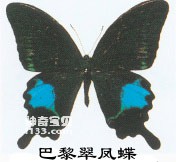Parisian Papilion butterfly adult: wingspan 95-125 mm. The body and wings are black or dark brown, scattered with green scales. There is a yellow-green or emerald green horizontal band in the sub-external area of the forewing, which is divided by black veins and interveinal lines. This band gradually narrows from the rear edge to the front edge, and the color gradually changes from dark to light, and disappears before reaching the front edge. There is a large emerald basket or emerald green spot on the upper part of the end of the hind wing. The outer edge of the spot is tooth-shaped. There is a light yellow, yellow green or emerald blue narrow stripe on the lower corner of the spot leading to the inside of the buttock spot, but sometimes it is not Less obvious; there are less obvious light yellow or green markings in the sub-peripheral area; there is an annular erythema on the hip corner; the outer edge is bluntly serrated. There is a very wide gray-white or white band on the sub-outer edge of the front wing on the reverse side of the wing, which gradually expands and weakens from the trailing edge forward. Colorless scales are scattered on the base half of the hind wings. There is a row of "W"-shaped or "U"-shaped red markings on the sub-peripheral area. There are 1 to 2 annular markings on the hip corners. The inside of the red spots is edged with white.

Oval shape, shallow concave bottom. Light yellowish white, smooth surface with weak luster. The diameter is about 1.28~1.30mm, and the height is about 1.05~1.20mm.
The 1st to 4th instar larvae are like bird droppings: the 1st instar larvae has a light brown head, obvious dark brown spots on the back of the chest, and white lines on the 2nd, 3rd and 8th abdominal segments; 2nd and 3rd instar larvae The body is olive-colored, with only the 2nd to 4th abdominal segments showing white streaks; the body color of the 4th instar larvae turns greenish-brown. The mature larvae have a light green head, bright green body color, and cloud-like spots on the dorsal side of the thorax; there is one eye-like red spot on each side of the metathorax; the front edge of the transverse stripe on the first abdominal segment is straight, and white spots are scattered in front of it. Small dot; a total of 2 yellow oblique lines are formed on the sides of the 4th to 5th abdominal segments and the 6th abdominal segment. Valve light brown. The stinkhorn is yellowish-white at first, becomes darker as it grows, and turns orange at the end of its life.
The body of the pupa is quite flat, with a pair of triangular protrusions on the top of the head. The sides of the middle thorax protrude outward at the front 1/3 and near the rear edge, making it slightly square. There are obvious ridges on the side of the body from the top of the head to the end of the abdomen. There is also a ridge in the center of the back from the front chest to the end of the abdomen, and the bulge on the middle chest and back is obtuse. There are also two types of pupae: green and brown.
Host: Rutaceae, citrus and other plants.
Biology: More than 2 generations occur in a year, overwintering as pupae. Adult insects like to visit white flowers and usually move high in evergreen forest belts. They fly quickly, are highly alert and rarely stop, making them difficult to catch.
Distribution: Henan, Sichuan, Yunnan, Guizhou, Shaanxi, Hainan, Guangdong, Guangxi, Zhejiang, Fujian, Taiwan, Hong Kong; India, Myanmar, Thailand, Laos, Vietnam, Malaysia, and Indonesia.
animal tags:
We created this article in conjunction with AI technology, then made sure it was fact-checked and edited by a Animals Top editor.